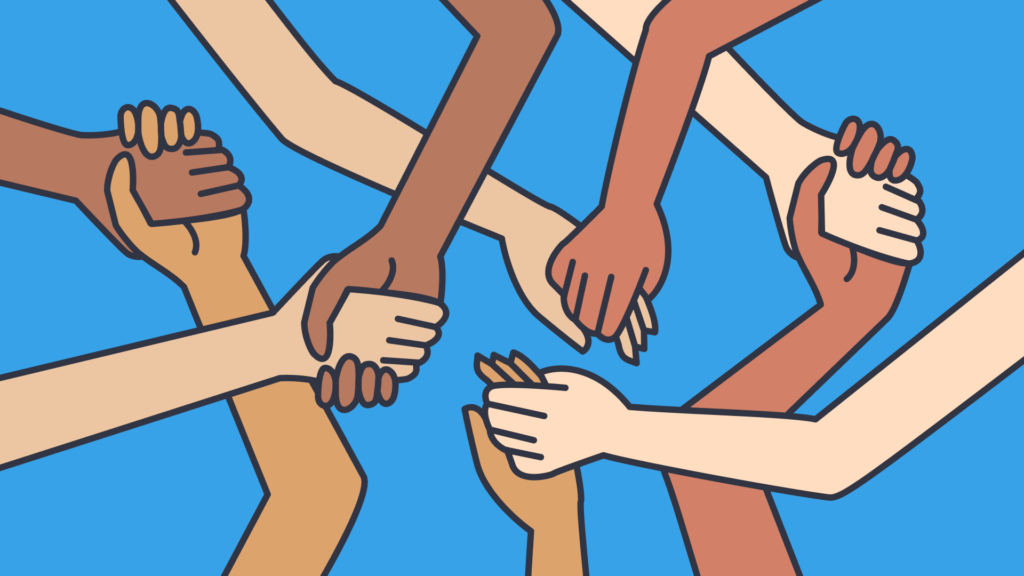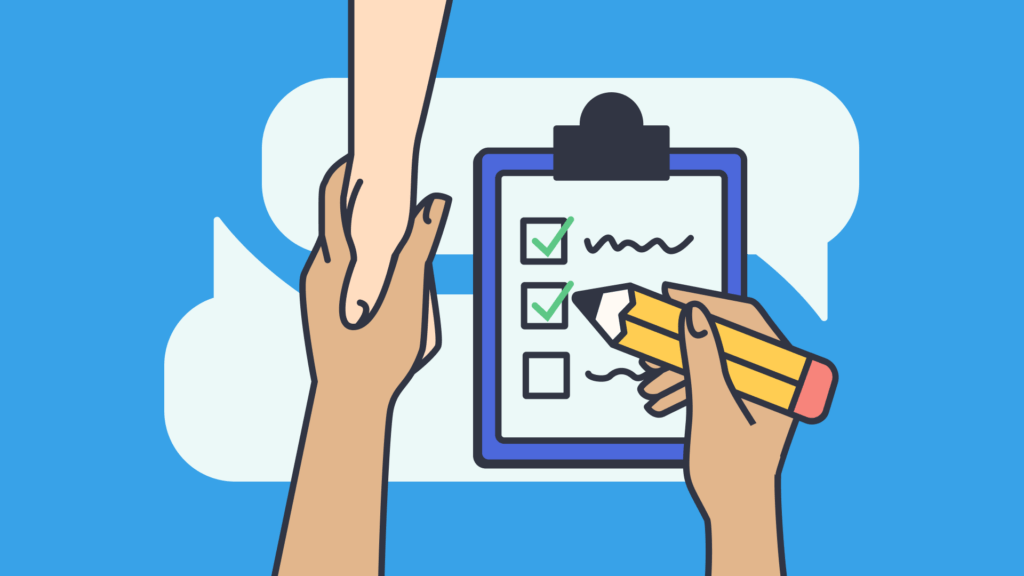9 Classroom social skills activities for kids
In this guide
Developing social skills activities can be challenging for teachers. Like academic skills, not all students are at the same social and emotional developmental stage.
Despite the challenges, all students need to be taught social skills, not just young children. As a former middle school teacher, I can attest to the fact that social skills are necessary throughout students’ education.
When determining what social skills activities to conduct with students, take into account your cohort; student individual needs, developmental levels, and time restraints.
Elementary students
Everyone experiences conflict at some point and students are not an exception.
1) Role-playing conflict resolution
Conflict resolution is a way for everyone to have their voice heard and come to a mutual resolution. Role-playing is one way that students can begin to develop their conflict resolution skills.
Sometimes bullying can be an issue and can require conflict resolution. Role-playing can help students learn how to deal with bullies. This activity can also help students learn about appropriate friendships.
Role-playing various scenarios allows students to be in a safe environment and also to learn about how other students resolve conflicts.
Directions:
- Divide students into small groups or partners.
- Give students a scenario to role play – use situations that have occurred in your classroom or from the list below.
- Students work through the scenario to find a peaceful resolution.
- The teacher can assign roles or allow students to choose roles.
Suggestions for role-playing scenarios:
- On the playground, two students want to use the swing at the same time.
- One student calls another student a name or says something mean.
- A student is left out when other students are playing together.
- A student accidentally bumps into another student and knocks them over.
- One student at the group table keeps taking up more than their allotted space.
After role-playing, allow students time to process what they learned. Providing time for them to reflect through journal writing or discussion can help to solidify their learning.
2) Listening Pictionary
Listening skills take time to develop. Students can develop their listening skills through actively listening to another student give directions. Active listening can help students to feel heard, to express their opinions, and to learn from each other.
Directions:
- Divide students into partners or small groups.
- Give one student a picture card. Only that student looks at the card.
- The other student(s) in the group need a piece of paper and a writing utensil.
- The student with the picture card describes the card in as much detail as they can.
- The other students replicate the picture being described.
- When they are finished students compare their pictures.
Reflection questions:
- Why is listening carefully important?
- What ways could you improve your listening skills? Your describing skills?
3) The human knot

This activity is fun to do with students and does not require extensive preparation. It challenges students to think and problem solve.
It is an activity I have done in my classroom, but also one that I participated in as a young student at summer camp.
Directions:
- Divide students into groups of 8-10.
- Students form a circle.
- Each student reaches out their right hand and grabs someone else’s right hand.
- Do the same with left hands.
- Students work together to untangle themselves without letting go of hands.
- Once students are untangled, discuss how working together, listening, and problem solving are important to success in this activity.
Make sure to have students wash their hands or use hand sanitizer when the activity concludes!
Middle school students
One of the hardest skills to develop in middle schoolers is teamwork. Students at this age tend to be more self conscious, and they are expanding their peer relationships. They are also learning about group dynamics and how to handle conflict.
In my own middle school classroom, I was constantly cognizant of the behaviors I modeled for students regarding conflict management and relationships. Students are learning how to relate to each other. I found myself frequently serving as a mediator or having conversations with students about how to handle social dynamics appropriately.
The goal of the activities for these grade levels is to help develop those skills.
4) Cross the room challenge

This activity helps students develop problem solving, communication, and teamwork skills. The object is for all students in a group to make it across the room following specific parameters.
Directions:
- Divide students into groups of 5-8 each.
- Give students four pieces of paper, fabric, or other similar sized flat object.
- Students must navigate across the room (or other specified points) using only their “stepping stones” (paper).
- They cannot go backwards and all students must cross the finish line.
Reflection questions:
- Was your group successful at completing this challenge? Why or why not?
- What would make this challenge easier? More difficult?
- Why is communication important in this challenge?
- If you were to do this challenge again, what would you do differently?
Tips and suggestions:
- If you have a large class, do this activity outside or in a larger space like a gymnasium or cafeteria.
- You can modify and one student in each group must be blindfolded.
- This activity can be changed to an obstacle course type activity. Use chairs, desks, and other classroom objects to create obstacles. Students must navigate through the obstacles without touching them while holding hands or while one person is blindfolded. The rest of the group directs the blindfolded person through the obstacles.
5) Spiderweb
The spiderweb activity is great for early in the year for students to get to know each other. Prior to completing the activity, students should identify a fact about themselves that they would like to share.
For this activity you will need a ball of yarn or string.
Directions:
- Students stand in a circle. Students can be divided into groups, or this can be done with the entire class.
- Each student identifies one piece of information they want to share about themselves.
- One student starts with the end of the yarn. They share their name and their fact.
- While holding the end of the yarn, they will toss the ball to someone else in the circle.
- Students continue until everyone has shared.
- Once complete, students should hold onto their yarn and take one step backwards.
- The “spiderweb” should be held taut.
- The teacher identifies a student to let go of their yarn. Then identify 1-2 more students.
- As students drop their part, the other students should observe what happens to the siderweb.
Reflection questions:
- How does this activity represent our class?
- How are we all connected?
- What happens when someone in the group drops their yarn and isn’t participating or helping the group?
- Why is it important for everyone to contribute?
- How can this be applied to group activities and classroom discussions?
6) Reflective writing
Reflective writing allows students to reflect on a situation, apply learned problem solving skills, and determine actions that could be taken in the situation.
Reflective writing is beneficial to students because it requires that students process information in a deeper way.
Directions:
- Give students a prompt or have them write about a situation they are currently dealing with in their lives.
- Students describe the situation, think about problem solving techniques they have learned, and apply those to the situation.
- They should address questions such as:
- What went well in this situation?
- What could have gone better in this situation?
- What other knowledge or experiences does this remind me of?
- What are other ways I could handle this situation?
This activity does not necessarily need to be graded. The important thing is for students to reflect and to identify ways to address situations in their lives.
If students are not able to readily identify a situation to write about encourage them to:
- Write about a conflict with someone in your life.
- Write about a situation that you are not sure how to address.
- Write about something you are struggling to understand – academically, socially, etc.
High school students
Students in high school experience many stressors and often do not know how to address them.
7) Stress management techniques
There are many ways to teach stress management, but the following three activities are short and easy to implement in a classroom with limited preparation.
- Deep breathing exercises:
An example would be box breathing. Below is an example of this deep breathing exercise:
- Step 1: Breathe in, counting to 4 slowly. Feel the air enter your lungs.
- Step 2: Hold your breath for 4 seconds. Try to avoid inhaling or exhaling for 4 seconds.
- Step 3: Slowly exhale through your mouth for 4 seconds.
- Step 4: Repeat steps 1 to 3 until you feel re-centered.
- Physical exercise:
Stand up and stretch, do jumping jacks, or jog in place. This is also a good way for students to take a brain break when the workload is becoming overwhelming.
- Progressive muscle relaxation:
This is a technique that has a similar effect to deep breathing. It can help to relieve tension. This is usually a guided practice that takes only minutes to do in the classroom.
Therapist Carolyn Mehlomakulu provides the following script to use with teens:
- Tense your feet by curling your toes. Hold 1-2-3-4. Relax and take a deep breath.
- Tense your legs by pulling your toes up and pointing toward your head. Hold 1-2-3-4. Relax and take a deep breath.
- Tense your stomach. Hold 1-2-3-4. Relax and take a deep breath.
- Tense your hands by squeezing into fists, and tense your arms by making muscles. Hold 1-2-3-4. Relax and take a deep breath.
- Tense your shoulders by pulling them towards your ears. Hold 1-2-3-4. Relax and take a deep breath.
- Repeat as needed.
As a high school teacher, I recognize that students may not want to participate or may feel awkward – they are at a time in their lives when they constantly feel this way! Allow students to opt out, but remind them that they cannot disrupt others.
8) Interview skills role-play

Role-playing is also beneficial for high school students. Many high school aged students have jobs or may be seeking a job, so provide them with an opportunity to practice their interview skills.
Role-playing allows them to observe how they should respond in an interview and what behaviors they should display. They can also have exposure to interview type questions.
Time may not allow for students to conduct a full interview, but you can give them questions to practice and limit the role-play activity to five minutes.
Directions:
- Break students into partners or small groups.
- Give them one question and have them take turns being the interviewer and the one being interviewed.
Reflection questions:
- What is one thing your partner did well?
- How could they improve?
- Why is it beneficial to practice for an interview?
9) Community service projects
Learning to help others is an important social skill. In my middle school classroom, students were required to complete six hours of community service each school year. They were given many different opportunities throughout the year and could also complete outside of school.
This requirement may not be easy to apply in every classroom, but students can be given opportunities to help others.
Some examples could be:
- Pick up trash around the school
- Donate clothing to a women’s shelter
- Make cards for a nursing home
- Read to younger students
- Donate canned goods to a local food bank
- Offer to sharpen pencils or cut out laminated items for teachers
The most important thing is to offer choices. Not all students are able to donate items, but may be able to participate in picking up trash at school. Helping others can help foster a sense of community among students and teaches them to recognize the needs of others.
Social skills are vital for all students. In an increasingly digitally focused world, students must learn the skills needed to relate to others.
References
- Mehlomakulu, C. (2016). How to Help Your Kids Calm Down. Available at https://www.therapywithcarolyn.com/post/2016/06/19/help-your-kids-calm-down-strategy-2-progressive-muscle-relaxation. (Accessed 12 July 2024).
- National Center on Safe Supportive Learning Environments (2024). How can schools successfully build the social and emotional competencies of middle school students? Available at https://safesupportivelearning.ed.gov/voices-field/how-can-schools-successfully-build-social-and-emotional-competencies-middle-school (Accessed 9 July 2024).
- Reinert Center for Transformative Teaching and Learning (no date). Active Listening to Support Inclusive Teaching. Available at https://www.slu.edu/cttl/resources/well_being/active-listening.pdf. (Accessed 8 July 2024).
- Rutgers University (2024). Conflict Resolution at School & on the Playground. Available at https://policylab.rutgers.edu/conflict-resolution-on-the-playground/. (Accessed 8 July 2024).
- University of Minnesota (2021). Using Reflective Writing to Deepen Student Learning. Available at https://wac.umn.edu/tww-program/teaching-resources/using-reflective-writing. (Accessed 12 July 2024).
WebMD Editorial Contributors, editor C. Nicole Swiner (2023). What is Box Breathing? Available at https://www.webmd.com/balance/what-is-box-breathing. (Accessed 12 July 2024).

Mattie Farrer
briefcase iconAVID Site Coordinator / Content Curator
Mattie Farrer has been an educator in various grade levels and capacities during her career. She has a passion for supporting English learners and their language development. She also loves helping teachers reach all students.
Other posts
Want more content like this?
Subscribe for blog updates, monthly video releases, trending topics, and exclusive content delivered straight to your inbox.













